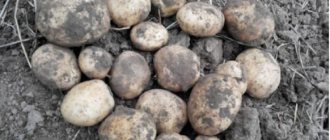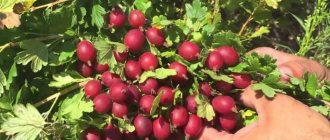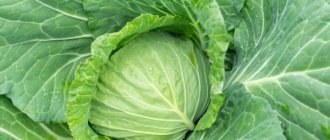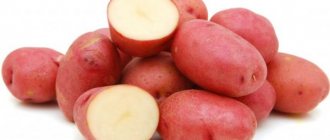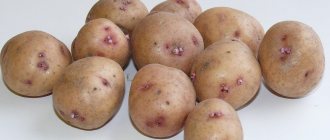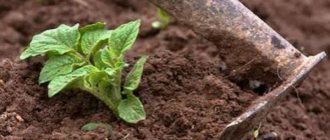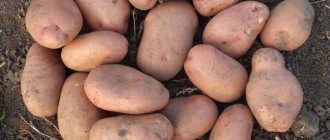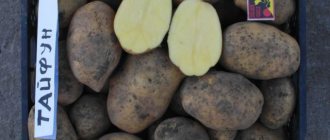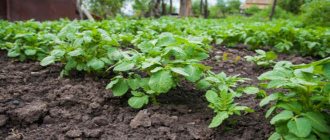Description of Zhuravinka potatoes
Without a doubt, a plant with this name could only appear in Belarus, which is called the birthplace of potatoes. Listen to the verbal chant, reminiscent of the farewell cry of cranes flying to their winter quarters in warmer climes. Experienced scientific breeders who work tirelessly not only create new varieties of plants, but also give them memorable names, glorifying their land and the work of its people.
The potato variety has not only a beautiful name, but also excellent biographical data. Based on the degree of tuber ripening, it is classified as a mid-late, high-yielding table potato variety. Among the advantages of Zhuravinka, farmers note good keeping quality - 96%, tuber weight - from 90 to 160 g, a large number of root crops in the bush - most often there are from 16 to 18. However, there are cases when the number of tubers reaches 25, and weight - up to 300 g. From 10 sq. m., as a rule, gardeners who own plots harvest from 75 to 80 kg of root crops.
From one hectare, with good care, experienced gardeners manage to get about 640 centners of excellent potatoes, distinguished by impressive tops, smooth skin of medium thickness and light yellow flesh with a strong consistency; there are no voids in the fruits. A slightly raised mesh is visible on the surface of the tubers even with the naked eye. In small root crops it is almost invisible.
The shape of potato tubers is oval and can reach 8-10 cm in length. The eyes spread evenly over the surface and are distinguished by their shallow planting, which is especially appreciated by housewives. Housewives also note the pleasant sweetish taste of potatoes, calling it excellent. From the tubers of the plant, which contain from 14 to 19% starch, you can prepare:
- delicious puree;
- wonderful chips;
- high quality chips;
- potato pancakes and many other wonderful dishes.
The tops of the plant reach a height of 50 cm. The stem is dense, with a diameter of 0.5 to 1 cm. The leaves are hard, bright green in color, and the edges are wavy. The flowers are small, purple-pink. The inflorescences are not prone to fruit formation; this potato variety practically does not reproduce by seeds.
Characteristics of tubers
The tubers of this variety are quite varied in appearance.
- The shape can be either oval-round or simply round. The surface of the tubers can be smooth, or it can be textured, covered with a kind of mesh.
- The peel is distinctly red, while the flesh is light yellow.
- The eyes are small, evenly distributed over the surface of the tuber.
- Tubers of this variety, photos of which are presented below, are quite large, up to 300 grams.
Although the average size varies from 92 to 145 grams.
- The Zhuravinka variety is also a leader in terms of the amount of starch in tubers. Its content can vary from 14.8 to 20%. With such a high starch content, the tubers of this variety can well be used for industrial processing and the production of potato starch. The pulp of Zhuravinka potatoes does not darken after heat treatment and boils well.
- The taste of potatoes is excellent. A wide variety of dishes can be prepared from Zhuravinka. This variety is used in the industrial production of potato chips.
- The marketability of the variety is also quite good, from 83 to 97%. This indicator determines the number of tubers suitable for consumption when digging potatoes.
Characteristics of potatoes
Ask agronomists which areas the potato variety, considered the pride of its republic, will surely love, and where it will not take root under any circumstances. The answer may surprise everyone. It turns out that this variety is so unpretentious that it is able to grow and bear fruit both in cold and warm conditions. The phrase “any region” in relation to the choice of place of residence, that is, planting, in the case of Zhuravinka potatoes is key. However, every time, starting to produce a new variety, Belarusian breeders set themselves the task of creating a variety that is ready to take root everywhere.
Considering that Zhuravinka was created in collaboration with specialists from the Russian peasant farm Niva, there is nothing particularly surprising. However, in the accompanying documents everything is strict and official: experts recommend Zhuravinka potatoes for cultivation in the North-Western, Central and Volga-Vyatka regions. 14 years ago, Zhuravinka potatoes were included in the State Register of the Russian Federation. And his triumphal march through towns and villages began.
Potato variety Zhuravinka: reviews, photos, description, planting and care rules
Currently, the most famous and high-quality varieties of flowers and vegetables are bred by Dutch breeders. Varieties of potatoes and many other vegetables of Dutch selection are popular among farmers and flower growers all over the world.
But famous potato varieties are not only bred in the Netherlands. Varietal potatoes from Belarus are also known to vegetable growers not only in this country.
Zhuravinka is rightfully considered one of the best potato varieties of Belarusian selection - with excellent indicators of yield, keeping quality, and disease resistance.
These and other qualities of the Zhuravinka variety will be discussed in more detail in this article.
The content of the article:
History of the variety Description of the Zhuravinka potato variety Productivity Advantages and disadvantages Diseases and pests Zhuravinka potato: planting and cultivation Further care Feeding the Zhuravinka potato Reviews of those who planted the Zhuravinka potato variety
Features of cultivation
Before you start planting a unique variety of potatoes in the ground, you need to prepare the tubers. The procedure takes place as usual and is practically no different from other types of plants. A few weeks before the start of sowing, planting material is taken out of dark bins and placed in boxes. To avoid attacks by Colorado potato beetles, it is recommended to treat the tubers with special compounds “Commander” or “Prestige” before planting. They really give positive results, protecting the plant’s roots from harmful insects and diseases, but they act only until the flowering period begins. Many people return to the use of chemicals that protect against Colorado pests one more time, but in each case they act individually.
Considering that potatoes are a multi-tuberous crop, farmers and gardeners need to remember that the distance between the beds should be at least 70 cm. And the distance between plants should be at least 30 cm. This will not only allow potatoes to be planted calmly, but will also allow them to enjoy the sun's rays. Otherwise, the harvest will not please you with either weight or size.
Harvest and storage
You can start digging up the vegetable a little earlier. But to store, wait until the tubers are completely ripe.
How and when to collect
Potatoes are harvested when the tops begin to dry out and turn yellow. Potatoes are dug up with a pitchfork or shovel. This is done carefully so as not to damage the tubers.
Storage features and keeping quality of the variety
The collected potatoes are dried for several hours in the beds, then sorted. Tubers selected for long-term storage are once again laid out to dry in a warm place out of direct sunlight.
After this, the vegetables can be stored in a well-dried basement or cellar. The temperature there should be +3..+4°C. The keeping quality of the variety is 96%.
Planting potatoes
Experienced gardeners know that they need to plant potatoes at an air temperature that is favorable for the planting process. In the situation with the Zhuravinka variety, this is 16-18 degrees. The soil requires special attention; it must warm up to 12-13 degrees; in such an environment the seed will be comfortable.
- For the northern regions, similar parameters characterize the first ten days of May.
- In the middle zone, the potato variety Zhuravinka begins to be planted in the soil in late April, and ends in May.
- In the southern regions of the country, planting begins in mid-April.
The most important factor when planting a plant of a unique variety is the soil. If the soil is dense and dry, the root system of the potato will be threatened, its development will slow down, and this will negatively affect germination. But if the soil is too wet, there is a risk of tubers dying. Therefore, agricultural engineers consider medium and light soil to be the ideal soil. When planting potatoes in holes, remember that their depth should not exceed 10 centimeters. Before planting tubers in the ground, experienced gardeners advise treating them with a growth stimulator.
Characteristic
Aboveground tops grow on average up to half a meter. The shoots are erect, but may deviate slightly from the center. The stem is powerful, the leaves are round, dense, dark green in color, with wavy edges. Shoots appear 12-15 days after planting and develop very quickly. The flowers appear at the end of June, are small in size and have a rich reddish-violet color.
The average yield is 75 kg per 10 square meters. Marketability is not lower than 93-96%. Keeping quality is excellent, no less than 93-95%.
The variety is characterized by resistance to the causative agent of potato cancer and nematodes, and is also not afraid of blackleg, late blight and various viruses.
Fact! If the Crane is cut, the flesh will not darken when exposed to air.
It is recommended to grow this variety on light soils. It reacts positively to the application of organic and mineral fertilizers, but does not tolerate nitrogen fertilizers well. During the growing season, it requires additional moisture, but only if there is a drought outside. Excessive waterlogging will negatively affect harvest volumes. Under normal conditions, potatoes can be stored for a very long time. Sometimes it even lasts until next summer.
Care
Caring for Zhuravinka potato varieties is both difficult and easy at the same time. On the one hand, it requires attention. On the other hand, it is quite unpretentious. Try to forget about timely watering, and the tops will immediately react with a lying strike. If you overdo it a little with water, you risk getting late blight. The same goes for mineral fertilizers. If you play around with adding nitrogen, you add more than necessary - the potatoes will lose their strength and taste. I forgot to fertilize on time, the harvest is in jeopardy.
The “X” hour for potatoes comes at the moment when the tops grow by 15-20 cm. This is the time for thorough weeding and first hilling - the roots need air. For good plant development, not only weeding is important, but also moderate soil moisture. Experienced gardeners, after watering and hilling the plants, cover them with mulch. This measure will preserve moisture and the effect of weeding for a long time. She has another tangible advantage. The plant, sensing care, begins to rapidly form adventitious trunks at the very roots, and this affects the increase in the future harvest.
So the gardener should think about the golden mean. But the variety has so many advantages that they more than cover all the troubles. With proper and timely watering, Zhuravinka potatoes will bring such a harvest that all the neighbors will be jealous. Add to this resistance to transportation, the ability to retain taste during long-term storage, impeccable appearance, because potatoes do not wrinkle until almost the very beginning of summer! Why is it not ideal for you?
Root crops are harvested as soon as the tops dry out and fall to the ground. You should not delay harvesting - it may begin to wilt. After harvesting, potatoes are dried in the shade and stored in a dry, dark place.
Hilling
The process of hilling a plant is considered one of the most important after planting, because thanks to this, the root system receives the oxygen necessary for the earth, weeds are destroyed, and as a result, the yield increases. Hilling up the soil is also a pest prevention measure. It is recommended to hill up the Crane for the first time when the plant reaches 15 cm. The soil around the bush is cultivated with a hoe, collecting it into a small mound.
The second time they take up the instrument after 3 weeks. This time corresponds to the beginning of the flowering period of the plant. The purpose of hilling the soil this time is to prevent root disease, control weeds and loosen the soil again.
Watering
Given the characteristics of the potato variety, which reacts to both aridity and excessive soil moisture, you need to monitor the weather. In times of drought, don't forget about your green friends. If dry weather drags on, the plant may shed its leaves, and this will affect the tubers, their quality and quantity. Potato beds should be watered in the morning or evening. On sunny days, in order to avoid burns to the leaves of the plant, this is strictly prohibited. If the temperature suddenly drops, and this happens quite often in recent years, watering the plant should be avoided to avoid late blight.
Charged by heavy rains? This happens periodically in the summer. Put on your boots and go to the garden beds. At this time, plants especially need human hands. To prevent moisture from stagnating and pests to attack weakened potatoes, you need to constantly weed and loosen the soil. Agrotechnicians advise not to disdain antifungal drugs during such a period.
Feeding
In order for the Zhuravinka potato harvest to meet the expectations of gardeners, it is necessary to feed the potatoes with minerals and vitamins. As a rule, fertilizers are dissolved in ten liters of water. Feed the potatoes while they are growing three times:
- before flowering - 1 tbsp. l. urea, 0.5 liters for each bush;
- during the formation of buds - 1 tbsp. a spoonful of superphosphate, 1 glass of ash, 0.5 liters for each bush;
- during the flowering period of the plant - 1 tbsp. a spoonful of superphosphate, 0.5 liters into the soil under each bush.
Features of planting and growing
When planting and growing, it is important to take into account the nuances in order to achieve maximum yield.
Preparing for landing
To obtain friendly shoots, potato tubers are prepared in advance for planting:
- Germination. 4 weeks before planting, the tubers are sorted and placed in a bright, warm room with a temperature of +13...+15°C.
- Landscaping. In order for solanine to form in the seed tubers, they are kept in the sun for a week.
- Treatment with disinfectants . Before planting, the planting material is sprayed with the preparations “Fitosporin”, “Maxim”, “Prestige” in order to protect the plants from attacks by wireworms, Colorado potato beetles and other pests.
After this, they begin to prepare the beds and plant potatoes.
Soil requirements
For planting, choose a sunny area where the groundwater is shallow.
Attention. After eggplants, peppers and tomatoes, potatoes are not planted on the plot for at least 3 years.
It is not recommended to plant the crop in dry and hard soil - this will affect germination. And planting in too wet soil will lead to complete loss of seedlings. The soil should be loose and nutritious.
Dates, scheme and rules of planting
The crane is planted when the air temperature rises to +16...+18°C, and the soil is warmed up to +10..+12°C.
In the northern regions, planting is carried out in the first ten days of May. In the central regions - at the end of April or beginning of May. And in the southern region - in mid-April.
Plant potatoes like this:
- Dig holes 15-20 cm deep. The planting pattern is standard. The distance between rows is 70 cm, and between bushes 30 cm.
- A handful of onion peels and wood ash are added to each hole.
- The seeds are planted with the sprouts facing up.
- The holes are sprinkled with earth so that air flows to the roots.
The depth of seed placement depends on the soil: for light soil - 10 cm, and for clay soil - 7 cm.
The crane emerges together and immediately begins to grow intensively.
Recommendations for cultivation
During the growth and development of the vegetable, follow the recommendations:
- The variety has a negative attitude towards excess nitrogen fertilizers. Therefore, it is better to underfeed him than to overfeed him.
- It is important to maintain the required distance between potato bushes, since each plant produces many tubers and they need enough space for full development.
- During the period of growth and flowering, plantings need additional moisture. But at the same time, the Crane does not tolerate waterlogging and begins to get sick if there is too much water. In rainy summers, carry out preventive treatment of bushes with Fundazol.
In general, potatoes respond well to the addition of mineral and organic additives. The variety is frost-resistant: if frost occurs after planting, the plants will not die.
Nuances of care
To form more large tubers, the variety needs proper care.
Watering mode
Zhuravinka potatoes do not like prolonged drought. Therefore, in the absence of rain, plantings need watering. The amount of irrigation depends on the condition of the soil and the presence of precipitation.
During the period of intensive growth, it is recommended to water the beds weekly. But do not over-moisten - in damp soil there is a high risk of late blight.
Watering is carried out in the evening or morning hours. Water calculation: 4-5 liters for each bush.
Top dressing
to feed the crop according to the following scheme:
- Before flowering . 1 tbsp. l. urea is diluted in 10 liters of water. Apply 500 ml of solution under each bush.
- During the formation of buds. 1 tbsp. l. Mix “superphosphate” and a glass of ash with 10 liters of water. For one bush – 500 ml.
- During flowering. 1 tbsp. l. “Superphosphate” per 10 liters of water. Consumption per plant – 500 ml.
Strictly follow the recommended dosages to avoid excess nitrogen. Otherwise, the potatoes will stop growing and new tubers will not form.
Weeding and hilling
When shoots appear, the soil is loosened, removing weeds, for better penetration of water and air to the roots. Then loosening is repeated as necessary so that a crust does not form.
When the bushes grow 15-20 cm high, they are hilled. To do this, a small hill is made in the area around the trunk.
Important! In the northern regions, the soil is loosened 5-6 times during the growing season.
The second hilling is carried out after 20 days. This time usually corresponds to the flowering phase. The procedure is needed to prevent root disease, loosen the soil and destroy weeds.
Disease and pest control
The variety is resistant to many potato diseases. However, a humid environment often causes the development of late blight. At the first signs of the disease - spots on the leaves, the plantings are treated with copper-containing preparations - Bordeaux mixture, copper oxychloride.
Among the pests, the Colorado potato beetle and wireworm are the most dangerous. But if other varieties of potatoes grow on the site, then the beetle does not land on Zhuravinka.
Attention. Treatment of plants against pests with chemicals is carried out no less than 30 days before harvesting the tubers.
The fight against the Colorado potato beetle is carried out by collecting it manually or using store-bought insecticides.
Diseases and pests
The Zhuravinka variety has demonstrated the highest resistance to diseases typical for this plant. He remains immune to the following diseases:
- potato nematode;
- common scab;
- blackleg;
- cancer (1st pathotype);
- viruses M, S, X.
However, there are potato diseases that can only be avoided with certain efforts by the owners of summer cottages. Among them:
- rhizoctoniasis;
- late blight of tops and tubers;
- root rot.
The main enemies of Zhuravinka potato varieties are Colorado potato beetles. But if any other types of potatoes grow next to this variety, the beetles give preference to them. Insects are controlled manually by removing them from plants and using insecticides.
Characteristics of the variety
The Zhuravinka potato variety is a medium-late variety, which means that from planting to harvest it usually takes from 90 to 110 days.
Productivity is one of the biggest advantages of the Zhuravinka variety. On average, it is about 400-600 centners per hectare. But it is known that it was quite possible to receive up to 700 centners. This figure is quite comparable to the yields of the best potato varieties from Holland.
Attention! One potato bush of the Zhuravinka variety produces on average 15-20 medium and large tubers.
It is important that, other things being equal, we can talk about the stability of such yield indicators. That is, it does not depend as much on environmental conditions as other potato varieties.
If we talk about such characteristics of potatoes as their preservation, then here too the indicators are at a high level. The keeping quality of tubers is estimated at 96%, which means that by spring only about 4% of potato tubers are in poor condition. The rest do not lose their commercial characteristics and, when used for food, are practically no different from tubers freshly picked in the fall.
An important positive feature of the Zhuravinka variety is that the tubers tolerate mechanical damage well.
Separately, it is worth emphasizing the fairly high resistance of this potato variety to various diseases. It completely resists potato cancer and golden nematode, shows sufficient resistance to scab, blackleg and some viruses, as well as late blight of tubers. Resistance to rhizoctonia and late blight of the aerial parts is low.
Reviews
“As soon as I learned about the Zhuravinka variety of potatoes, I began to grow these potatoes. I can’t boast that everything came together right away. Let me note: the plant variety gives a rich harvest in those regions that, in terms of climatic conditions, are close to Belarus. It is stored well, when other varieties lose their marketable appearance, Zhuravinka looks so that you can put the root crops on the counter right now,” Mikhail Bystrov, Kostroma.
“Last season I planted one variety of potato – Zhuravinka. There was little trouble with the plant, that's true. But the harvest wasn’t very good either. There are many tubers, but mostly they are small. I left the root vegetables for seeds. I consulted with my neighbors about what I did wrong. They say she didn’t look after her enough - the first half of summer in our region was rainy. It was necessary to constantly hill up, protect from pests, so the harvest would have turned out, but I relied on advertising, and “maybe,” - Maria Ivanova, Bologoe
“It's a good plant. There is little fuss with the Zhuravinka variety, but it is important to prepare the seed and care for it right away. From a bag of tubers they grew such a crop of root crops that there was enough for themselves, their children, their neighbor gardeners, and there was a little left for sale. I recommend it to everyone,” Ivan Spiridonov, Belgorod.
“For our family, the Zhuravinka variety is the best variety of all types of this plant. During the cooking process, its tubers do not fall apart and do not lose their delicate color and taste. But the puree from root vegetables turns out tasty and crumbly; frying it is also just right. For people who consider potatoes their second bread, this is a good choice,” - Sivakov family, Tver.
Reviews from gardeners
Gardeners all over Russia love to plant Zhuravinka potatoes, so there are many reviews, and they are different, but generally positive.
Victoria, 28 years old, Victoria, 28 years old
We have been planting crane grass for 3 years now. So far we really like her. Potatoes have a wonderful taste and, most importantly, store well. The only thing that is bad for our latitudes (Non-Black Earth Zone) is that it takes too long to grow - after all, it is a late variety. But there is an advantage to this - you don’t have to dig up all the potatoes at once, but collect different varieties at different times. After all, we plant 30-36 varieties at a time on our site every year.
Mikhail, 34 years old, Nevinnomyssk
Everyone in our family really loves the Zhuravinka variety of potatoes, so for several years in a row we have been planting only this variety. But last summer was very dry, there was no rain at all in June, and in the end we were a little disappointed in the harvest - there were very few potatoes, and those that did grow were mostly small. Now we are thinking about planting several different varieties so as not to end up in such a situation again.
Lyudmila, 35 years old, Ulyanovsk
This year I decided to try planting Zhuravinka. I bought 10 pieces of small potatoes. After landing, my kids became interested in them. I didn’t keep track of them, so they dug up half of them and fried them on the fire. But from those that remained in the ground, I collected almost two buckets of large, good potatoes. We tried to cook it to test its taste - we liked it. Now I save the rest for seeds. I think the potatoes will be good, although what kind of vegetable grower am I?
Margarita, 32 years old, Saratov
I just love the crane. There is a lot of starch in it, so it boils so much that sometimes there is nothing left of the potato itself. It stores very well, which is an additional plus. However, it is late, and they are usually stored well. Likes the soil to be loose. It is better to plant it separately from others. To avoid confusion and removal ahead of time.
Elizaveta, 36 years old, Volkhov
We test different varieties of potatoes all the time to choose the best ones for ourselves. For several years I planted Belarusian varieties, including Zhuravinka. Basically, the varieties were not suitable for our rather harsh climate, they produced a meager harvest, and the tubers themselves were not large enough. I was only pleased with the Zhuravinka variety - it turned out to be the most productive. Under each bush there were always at least 20 tubers, although their size was small. It turned out to be resistant to scab and late blight on tubers. But late blight kept trying to get down from the leaves - I had to tear off the leaves. The only disadvantage we can note is that it requires planting only in a sunny place. No partial shade. And in dry weather it requires watering.
Useful video
Below in the table you will find links to articles devoted to potato varieties that ripen at different times:
| Mid-late | Mid-early | Late ripening |
| Aurora | Black Prince | Nikulinsky |
| belongings | Nevsky | Asterix |
| Courage | Dark-skinned girl | Cardinal |
| Rowanushka | Lord of the Expanses | Kiwi |
| Blue | Ramos | Slav |
| Zhuravinka | Taisiya | Rocco |
| Lasunok | Lapot | Ivan da Marya |
| Sorcerer | Caprice | Picasso |
If you find an error, please select a piece of text and press Ctrl+Enter.
Harvesting
Two weeks before the planned harvest time, potato tops need to be mowed and removed off site. During this time, the tubers develop a thicker and rougher skin, which will prevent possible injury during harvesting and ensure better storage in the future. Harvest in dry, sunny weather. The harvested crop must be dried for 3-4 hours in the sun.
HELP: If it rained during harvesting, the tubers need to be dried under a canopy for a week.
Growing and care
The variety requires moderate moisture with rare precipitation. Moisture norm per 1 sq. m - 30–45 l. Waterlogging of the soil is dangerous due to fungal infections (infection with late blight, blackleg). Water for the first time 10–14 days after germination of the seedlings, then at the beginning and at the height of budding.
To cultivate the soil surface, use a Tornado ripper, a hiller, a plow, and a walk-behind tractor. The earth is loosened systematically after rains and waterings. Hilling is carried out 2 times - with stem lengths of 10–15 cm and 20–26 cm. The procedure is carried out in the evening on non-hot soil. The height of the embankment is 2/3 of the length of the tops.
Fertilizers are applied during the growing season (urea, manure, nitrophoska). During flowering, the root method and foliar spraying with phosphorus-potassium solutions are used. Superphosphate is scattered over the beds at the rate of 400 g per 1 sq.m. (for better preservation of the crop).
Potato variety description. Classification of potatoes by ripening time:
- Early potato varieties - a good harvest can be obtained 2 months after planting. Such varieties tend to effectively use moisture at the beginning of summer. Thanks to this, some of them can produce the first harvest already 40-50 days after germination (the variety of the Ukrainian selection Dnepryanka and the Dutch selection Impala). Among other early varieties, it is worth noting potatoes of Russian selection (Udacha, Zhukovsky, Krasavchik, Belosnezhka, Baron), potatoes of Ukrainian selection (Tiras, Fantasia, Kievsky, Svitanok, Serpanok), potatoes of Dutch selection (Karatop, Rodrigo, Bellarosa, Nikita, Adretta) , potatoes of Belarusian selection (Caprice, Dolphin, Askamit, Bronix). Medium potato varieties. Early ripening - 65-80 days. Such varieties are distinguished by the presence of powerful tops, high moisture consumption, and resistance to changing climates (Gala of the German selection), (Santé, Condor, Red Scarlet - Dutch selection). Mid-season - 75-90 days (Nevsky, Lazar, Resurs, Yurga, Tuleevsky Russian selection). Late ripening - 90-110 days (Rocco, Romano, Ramos - Dutch selection). Mid-season potato varieties are more resistant to late blight disease than early ones. Late - the ripening period is more than 120 days. These include varieties Picasso, Rodeo, Mondial - Dutch selection; Grouse - Ukrainian selection; Lorch, Vityaz, Malinovka - Russian selection. Such varieties are resistant to many diseases, are not afraid of excessive soil moisture, and are resistant to changing climates and adverse environmental factors.
How to feed Zhuravinka potatoes
To increase the yield of the variety, it is recommended to apply several fertilizers to Zhuravinka potatoes during the summer season:
- Before flowering begins, you should feed the potatoes with a urea solution (15 g of urea per bucket of water). Liquid fertilizer should be applied strictly at the root; each plant requires no more than half a liter of such a solution;
- during the period when buds appear, prepare the following solution: 100 g of ash and 15 g of superphosphate are diluted in a bucket of water, no more than 0.5 liters of this fertilizer are applied to each plant;
- during flowering 1 tbsp. l. superphosphate is diluted in a bucket of water and no more than 0.5 liters of solution are added to each bush.
Important!
During the growth period and before the start of flowering, you should not get carried away with nitrogen fertilizers - their excess in the soil has a negative effect on the growth and maturation of root crops, as a result, the yield decreases.
Landing rules
In the central regions, “Zhuravinka” should be planted in the second half of May, and in the southern regions - at the end of April, when the threat of return frosts has completely passed and the soil has warmed up sufficiently to a depth of 20 cm.
The maximum productivity of the variety can be achieved when planted in black soil or lighter soils. It is also permissible to plant in heavy soil with the preliminary autumn application of peat, sand, manure and finely chopped straw. In this case, the beds should be well lit. Their preparation includes loosening to a depth of 20 cm. It is not recommended to add organic matter to the soil, since with increased nitrogen, excessive growth of the above-ground part occurs, which negatively affects the formation of tubers. Pre-sowing preparation of seed potatoes is no fundamentally different from other varieties.
Since “Crane” belongs to the category of multi-tuberous species, when planting, holes should be made at a distance of 30 cm, and at least 60 cm should be left between rows. This will allow for high-quality hilling of the bushes, improve their lighting and ensure good ventilation.
Important! The planting depth of “Zhuravinka” when planting in heavy soil is 8 cm, and in lighter soil – 10 cm.
Features of care
Caring for Zhuravinka will not be too different from cultivating other varieties. However, there are still some nuances.
Familiarize yourself with the agricultural technology for growing the following potato varieties: “Irbitsky”, “Kiwi”, “Ilyinsky”, “Slavyanka”, “Zhukovsky Ranniy”, “Rocco”, “Nevsky”, “Udacha”, “Rosara”, “Golubizna”, “ Gala", "Queen Anne", "Adretta".
Care will need to begin five days after planting. The first steps will be watering and loosening. Recommended watering rates are 3 liters per bush. Loosening should begin only at the moment when the soil has completely absorbed water.
The amount of watering will vary depending on the season and the weather. On average, it is recommended to do this three to five times during the growing season.
Once the shoots reach a height of 15-20 cm, they will need to be hilled up to stimulate the formation of adventitious roots. It is better to carry out the procedure after precipitation or watering in the evening or early morning. The second hilling will need to be done 20 days after the first.
Important! If the weather is dry and there is no possibility of frequently moistening the soil, then hilling should be replaced by ordinary loosening.
Vegetable crops are fertilized a month after planting: in the south - in May, in the north - in June. Urea superphosphate fertilizing
The plant also responds well to foliar feeding. They can be combined with preventive spraying. For example, foliage can be treated twice a season with a mixture of superphosphate, potash fertilizer, and Bordeaux mixture.
Scrub potatoes. Potatoes Scarb
- 1 Description of the variety Scarb
- 2 Advantages and disadvantages of Skarb
Potatoes are already an integral part of the table of any family. Russian, Ukrainian and Belarusian cuisines generally cannot do a day without this root vegetable.
But for those who plant it, it is known that not all varieties take root in different climatic conditions, they are not always stored in the cellar for a long time, and not all have excellent taste. Therefore, when choosing a variety for planting, it is necessary to analyze reviews, photos, descriptions of the variety, which is considered as planting material.
After all, no one wants to spend a year growing tasteless “peas.”
Description of the variety Scarb
Everyone is accustomed to the fact that most of the famous varieties were bred by Dutch breeders. Indeed, they work hard and delight with such varieties as Impala, Sante and others. But, unfortunately or fortunately, this variety was not developed by the Dutch. Scarba's homeland is Belarus.
It entered the State Register of the Russian Federation in 2002, which makes it a relatively young potato for Russian residents. But, despite high competition, it has already become the main variety for many agronomists and ordinary families.
After planting, harvesting is possible within 2.5-3 months. This ripening period makes Scarb potatoes a mid-season variety.
The peel of the root vegetable has a pale yellow color. The surface is flat and smooth. The tuber ripens large and is an ideal product for sale. The average weight of a root crop reaches 200 grams. There are specimens whose weight is 250 grams.
Under favorable conditions, Treasure produces a high yield. One bush produces from 12 to 16 large tubers.
The pulp of the fruit is tasty and tender. The average starch content is 15-16%. During heat treatment, the root crop cracks. If overcooked, it turns into a velvety “mush”. Suitable for pureeing and frying.
Scarb itself is unpretentious to the type of land. But if the soil is waterlogged, development will slow down. After all, the variety has such a feature: it tolerates drought well and can easily do without water, but with heavy rain or watering it begins to rot or stops growing, right in the hole.
We recommend reading: “Impala Potatoes”
It has a fairly strong peel that protects it during transportation. The keeping quality indicators are also okay.
Advantages and disadvantages of Scarb
The description of the variety has both positive aspects and disadvantages. To summarize, I would like to briefly highlight each of them.
Advantages:
- Stable high yield. This variety is a suitable option for entrepreneurs, as it has high profitability.
- Every gardener, and even an ordinary person, knows that Belarusian potatoes Skarb have excellent taste.
- Quite early ripening of root crops. After 3 months the harvest is harvested.
- Adaptability to any weather conditions.
- Good preservation without loss of quality.
However, as mentioned above, in addition to the positive aspects, it has some disadvantages. Among them:
- Weak resistance to leaf blight. If everything goes well with the tubers, then many agronomists will have to deal with damage to the leaves by this disease.
- Attractive not only to people, but also to parasites such as wireworms and the Colorado potato beetle.
- Inhibition of development due to waterlogging of the soil.
Disadvantages are encountered only with improper care. Then, when improper planting is done, there will be no weed removal, hilling, or soil fertilization. If you take a good approach to the issue of growing your belongings, then neither Colorado nor late blight will become a big problem.
People's reviews give a complete description of this potato.
Tanya.
We live in a small town. We often go to the market, but not for potatoes. We grow at home. Now the main variety we plant is Scarb. Overall we are more than happy with it.
The yield is excellent; in general, from 1 bucket we collect 6-7 buckets of young root crops. There are a lot of tops, it is inconvenient to dig the crop, but this is a minor drawback. The only thing I don't like is the long ripening time.
To remove this disadvantage, we plant 3-4 rows of an early ripening variety. By the time we dig it up, the belongings will already be ripe.
Vika.
The variety is good. The potatoes are yellow and overcooked. The taste is excellent, does not taste bitter, does not sting. A solid 5.
Lena.
Basic growing rules
When planting, keep your distance.
The first and most important rule is that you should never plant root crops close to each other. The ideal distance between rows is 60 -80 cm; if the distance is less, then the roots of another bush will grow on the roots of its neighbor, and this will lead to a small yield. Between the bushes themselves, it is ideal to maintain a minimum distance of 20 cm and a maximum of 26 cm. Depending on the type of soil you have, the depth of planting of root crops will also be selected.
If the soil has a more clay structure, then the holes can be made small, about 6-8 cm, and if, on the contrary, there is a large percentage of sand in the soil, then it is best to dig a hole 10 cm in size. Also, depending on the area where you live, the and landing dates. If you live in Moscow and the northern territory from it, then it is best to plant fruits in mid-May, and if in the other direction, then you already need to plant fruits in early April or early May (in the early days).
Gardeners also recommend cultivating and preparing the soil for planting before planting. Treat the planting material itself with Zircon or Corvitol - these products will help to activate the activity and growth of the plant.
Main conventions of growth
The crane does not grow well in soil that is oversaturated with nitrogen. But, in general, the species is not very demanding on the soil; the most important thing is to choose a place in the sun and water them after 3-4 days.
Before planting, the soil must be made looser, and the main soil granules should always be small to medium in size. Basically, this is the most common garden soil, which is fertilized with organic additives.
Storage conditions
To get a good percentage of yield, it is best to properly approve the soil of the area and the distance between the holes. Therefore, if you adhere to standard planting rules, then from 10 m2 you can get more than 70 kg, that is, from 1 hectare you will get a minimum of 630 kg, but a maximum of 750 kg.
In addition, the species has excellent storage and transplantation characteristics. You can keep Zhuravlinka potatoes in a cold place, preferably in a cellar. In this case, you will have access to fresh potatoes throughout the winter.
Peculiarities
Characteristic features of the variety:
- The growing season lasts from 100 to 120 days;
- Productivity reaches 640 centners per hectare;
- Rare planting of tubers is recommended;
- Thanks to the strong root system, high yields are guaranteed even in unfavorable weather conditions;
- During periods of sharp temperature changes, approximately 40% of the foliage of the Zhuravushka potato dies off, which is a small percentage compared to other varieties.
Reviews about the variety
Potatoes of the Zhuravushka variety are popular among gardeners due to their good taste and high, stable yield. Has a huge number of positive reviews. To obtain consistently high yields, potato growers and agronomists recommend not to forget about the excellent responsiveness of the Zhuravushka variety to fertilizers; however, exceeding the dosage of nitrogen fertilizers negatively affects the quality characteristics of root crops.
We invite you to familiarize yourself with potato varieties that have different ripening periods:
| Late ripening | Early ripening | Very early | Mid-late | Mid-early |
| Nikulinsky | Borovichok | Forty days | Crane | Yanka |
| Cardinal | Elmundo | Karatop | Sorcerer | Giant |
| Rocco | Felox | Riviera | Mozart | Tuscany |
| Kiwi | Bellarosa | Zhukovsky early | Grenada | Purple Haze |
| Ivan da Marya | Natasha | Farmer | Melody | Openwork |
| Picasso | Ariel | Minerva | Margarita | Santana |
| Asterix | Queen Anne | Veneta | Ramona | Desiree |
| Slav | Arosa | Kiranda | Dolphin | Lady Claire |
Growing potatoes of the Zhuravushka variety will be an excellent choice for gardeners. The high yield of the variety is facilitated by good adaptability to external environmental conditions and high resistance to diseases and pests. In addition, the tubers have an unsurpassed taste in any form.
Potatoes and new varieties are being studied in Belarus:
Advantages and disadvantages
Advantages of this variety:
- Attractive presentation of root crops;
- An ideal combination of productivity and labor intensity during cultivation;
- Safety in winter is at least 96%;
- Resistance to most specialized diseases;
- The ability to transport over any distance thanks to the durable peel, and the ability to harvest using special equipment.
Potatoes Tuleevskaya and Zhuravinka:
The main disadvantage of Zhuravinka is its demands for balanced watering.:
- During drought, the tops begin to rapidly wither and lose leaves;
- When there is excess moisture in the soil, root crops begin to rot.
